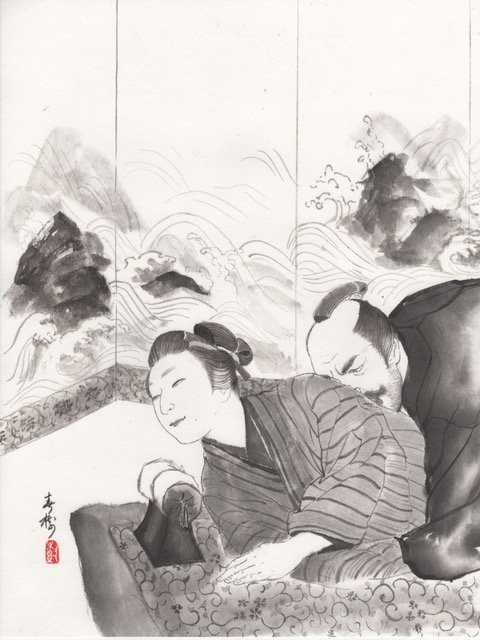Finding joy in tradition with painter Noah Haruki
Painter Noah Haruki connects with his heritage through his homoerotic paintings. We connected with Noah to learn more about how his experience as a third-generation Japanese Canadian artist influences the lines of tradition and exploring beyond the boundaries.
Pride in Business: What first inspired you to become an artist?
Noah Haruki: Growing up I was exposed to a lot of artwork in general. My dad used to be an illustrator and my mom had also gone to art college. So, they were both really supportive of me and my brother getting into art and they both really encouraged me and my brother to do a lot of art growing up. And so, it's always been something that I've really enjoyed doing and not only is it kind of an outlet for creativity, but also is just like a fun activity. And the more that I've gotten into it, especially recently, the more I've kind of been pushing myself to get better and better.
PIB: How long have you been a practicing artist?
NH: I guess probably late high school is when I started getting more into traditional Japanese style art and when I started connecting with it more. Especially after going to Japan as a family, I think was when I really got super inspired to get into it and especially using more traditional mediums and that sort of thing.
PIB: As a third-generation Japanese Canadian you speak about reconnecting to your heritage with art. When you first started painting what did you find most exciting about this style and this medium?
NH: I think a lot of the excitement started coming from when I was able to get my art to a point that it resembled artists that I really looked up to, and when I could really see kind of how my techniques were developing to the point where it resembled artists that I really admired. Especially since Japanese artists are like the old masters. I think that's when I started getting really excited about it and wanted to really push myself further to get into it more. I guess the other exciting part is, like you said, connecting with my heritage. It is knowing that this is something that is part of my roots in terms of being Japanese. It's very fascinating to me. And I've always found Japanese art to be very beautiful.
PIB: What would you say are some of the overarching values in Japanese art?
NH: A lot of themes are related to Zen philosophy and Zen Buddhism. So, in Zen Buddhism, there's a lot of strong values placed onto appreciating the world as it is in a sense or the things that you know might be considered imperfect, or not beautiful, or showing signs of decay, or that sort of thing are really heavily emphasized in Zen art. They are meant to be dwelled on and appreciated rather than hidden away. I think that that's also something that's really kind of resonated with me and something that I've always really enjoyed about Japanese art.
PIB: Seeing as you work with traditional techniques and styles, how has your Canadian heritage influenced your work in this style?
NH: Yeah, certainly I feel like because I've grown up in Canada, I think I have a lot more freedom to use the mediums as I see fit, to cover topics that I think are maybe more taboo in Japan. Japan in general is quite rigid, especially when it comes to traditional arts and a lot of the stuff that I like to draw doesn't necessarily fall within that framework or within that kind of rigidity of the culture. So, I think being Canadian has really empowered me in a sense to take my own spin on things more, and feel less restricted in that sense. I've been meaning to incorporate more Canadian and more local things into my art, and I think that's been kind of easier with the ceramics that I do. I do some ceramic work as well, some pottery which will not be a part of this show, of course. I think with the painting, I've been sticking more with Japanese themes and subjects, but being Canadian and growing up with a lot more freedom has kind of given me a lot more flexibility and creativity as an artist
PIB: Your work features homoerotic tones and displays the male form. Using these erotic elements, what do you hope to convey when people view your work?
NH: I guess I want people to kind of enjoy, to get a good feeling out of it for the most part. I think part of the reason that I really enjoyed the Japanese aesthetic is because it is very beautiful, and I think it's something that people can easily enjoy and appreciate. It's also something where I kind of want in some ways to show how Asian men can be more sexual or more sexually appealing. I think in a lot of ways in Western media, Asian men have been very undersexualized, which is changing more in recent times, of course. But I think up until now it's been like there aren't many kinds of Asian male sex icons or that sort of thing. So, in some senses I kind of want people to see that and appreciate that in my art.
PIB: What would you tell new up-and-coming artists trying to make a name for themselves in Calgary?
NH: I guess my experiences with working in Calgary and art has been kind of limited in a sense. Like Calgary’s where I'm based and that's where I produce all my art, but most of the stuff that I do and most of the popularity that it's gained has seemed to be online and very international in the sense. So, it's hard for me to really talk about getting into the Calgary art scene specifically. But I would say for any kind of up-and-coming artists, it's important to really take the time to explore your mediums and just really practice and see what advantages certain mediums have over others and how you can push them or work them to produce the kind of art that you find interesting or that you I feel as beautiful to yourself.
Website: noahharukiart.com
Instagram: @samuraibara
ABOUT THE AUTHOR
Michael Fong
PIB — Communications, Events, & Social Media Manager
Pride In Business article in partnership with TD.
By Michael Fong
Pride In Business article in partnership with TD.
By Michael Fong













